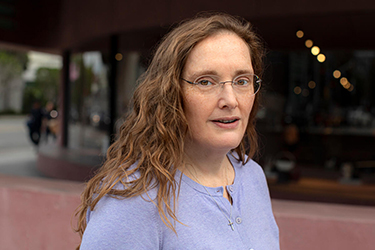Discoveries
Transforming Epilepsy for the Next Generation
Victoria Pelham. Illustration by Bryce Wymer.

Just a decade ago, pediatricians had few options for treating a child with severe, incessant seizures deep inside their brain. Nor could they determine exactly what was causing the misfire.
Today, sweeping technological and genetic advances are reshaping epilepsy, allowing for individualized treatments and more control over the most common childhood neurological condition. However, this progress has not reached all of the approximately 470,000 U.S. children with epilepsy.
A widespread shortage of pediatric neurologists results in these young patients often being unable to see specialized doctors who can provide optimal treatment. Some patients fail many epilepsy drugs, never finding a solution.
The new Pediatric Epilepsy Program at Cedars-Sinai Guerin Children’s is harnessing progress and expanding treatment access to protect young minds during critical years of learning and growth. Leaders aim to make a dent in yearslong diagnostic delays, frequent hospitalizations and decreased survival for children with epilepsy, who have fatality rates that are five to 10 times higher than their peers and are more vulnerable if the disease is uncontrolled.
The program’s director, Deborah Holder, MD, believes that using rapidly evolving science to intervene sooner—potentially even before an infant’s first seizure—will stretch the realm of what is possible.
“Stopping seizures in a baby really changes their life forever,” she stressed.
Caring for Children in Need
There are 20% fewer pediatric epileptologists and neurologists than needed to meet national demand, according to the Child Neurology Foundation; about 19 states have none.
“There’s a huge, unmet need for epilepsy specialists,” said Guerin Children’s epilepsy neurosurgeon David Bonda, MD. “We’re here to start to chip away at that massive gap in care.”
The program’s new-onset seizure clinic conducts thorough brain and electrical imaging and metabolic, lab and genetic testing within days of a child’s first known or potential seizure. This robust approach can detect epilepsy in patients with easily overlooked symptoms—such as staring, confusion, inattentiveness and repetitive motions. Without such testing, these children often cycle through emergency rooms and physician waitlists while being undiagnosed or mistakenly assigned behavioral disorders.
The Neonatal Intensive Care Unit (NICU) at Cedars-Sinai Guerin Children’s also carefully observes any infant with signs of neurological injury and partners with pediatric epileptologists to discover subclinical seizures, which only appear on electroencephalograms (EEGs).
Stopping seizures in a baby really changes their life forever.”
— Deborah Holder, MD
For older children, a four-room epilepsy-monitoring unit at Guerin Children’s gives providers access to the latest tools to investigate a case and determine a care plan, including whether a patient is a candidate for neurosurgery.
About 65% of children with epilepsy respond to the ballooning number of 25 approved anti-seizure medications. Roughly half will respond on the first attempt, and the rest will respond by the second.
Epileptologists are concentrating on the 35% of children with refractory epilepsy, a rate that has persisted since the 1970s. These children are much more likely to die suddenly in their sleep or from catastrophic accidents while swimming or riding a bike. Their activities are limited, as they are frequently forced to rely on caregivers due to “trouble getting from day to day,” Holder said.
Neurosurgery can be a game-changer for these patients, although specialists face an uphill battle against fear and lack of awareness.
“Surgery is actually not a last resort and should be done well before failing repeated drugs,” Bonda explained. “Some parents think it sounds scary and overwhelming, but it’s a safe alternative. The earlier you get rid of seizures, the better the child does.”
Zeroing In On Treatments
Sharper brain imaging—MRIs, EEGs and new magnetoencephalography (MEG) scans—is making surgery more precise, safer and faster. Further, stereotactic-guided tools and minimally invasive lasers allow surgeons to pinpoint and remove damaged areas in the brain with minimal or no functional disruption.
In addition to laser ablation and surgical resection, surgeons have the option to implant a range of neuromodulation devices in either the brain (responsive neurostimulation and deep brain stimulation) or neck (vagus nerve stimulation). These implants send electrical surges to the brain that stave off or halt seizures, curbing them by about 70% to 80%, according to Bonda. Neuromodulation is especially helpful for children whose seizures are too spread out to target with traditional surgery.
For some patients, epilepsy has genetic roots. Researchers have identified more than 550 genes connected to the condition—a staggering fivefold jump over the past 10 years, with more uncovered annually.
We’re fixing the problem right at the cause instead of treating the symptoms.”
— Deborah Holder, MD

Dr. Deborah Holder is the director of the new Pediatric Epilepsy Program at Cedars-Sinai Guerin Children's
Epileptologists can now examine the responsible genes and treat many underlying genetic disorders. For example, glucose transporter type 1 (GLUT1) deficiency syndrome, which is brought on by SLC2A1 gene variants, interferes with the protein responsible for blood glucose delivery. Since the brain’s energy supply comes mostly from glucose, the disturbance can trigger seizures. By exploiting a different form of transport, a ketogenic diet replaces missing sugar in the brain.
Dravet syndrome acts on the SCN1A gene and causes intense, convulsive seizures—usually before an infant’s first birthday. Genetic recognition has opened the doors to more effective, tailored drugs targeting the sodium channel.
“Everybody who has a seizure should get genetic testing, because it makes their doctor more knowledgeable, leading to more informed care,” Holder said.
The Guerin Children’s team is prioritizing genetic testing for every pediatric epilepsy patient and has an eye toward standardized newborn screening. They hope to study whether early knowledge of a predisposition could identify seizures that would otherwise be missed, potentially sparing thousands of children from highly prevalent developmental disabilities and lasting cognitive effects.
“These children have a ticking clock in their heads,” Holder said. “If they don’t get their seizures controlled in that window of opportunity, they’re not going to learn how to think or learn optimally.”
A Precision-Medicine Revolution
Experts see gene therapies as the next frontier. These treatments could correct underlying mutations, eliminating seizures altogether and preventing or helping repair damage to the brain and other organs.
“We’re fixing the problem right at the cause instead of treating the symptoms,” Holder said.
The Pediatric Epilepsy Program at Guerin Children’s will engage in a Phase II gene therapy clinical trial, as well as precision-medicine studies for genetic conditions related to epilepsy. Other involved genes act on potassium, sodium, calcium and chloride channels.
Treating newborn infants is central to Holder’s vision. There are many babies born at Cedars-Sinai or hospitalized in the NICU whom specialists could—for the first time—diagnose and care for before their seizures become problematic.
Holder explained that on-site genetic testing will soon provide seamless, high-quality care to patients while bolstering investigation of genetic variants of unknown significance to better determine if they cause disease.
Guerin Children’s specialists are enhancing epilepsy surgery through new software, data visualization and state-of-the-art approaches to Phase II studies to locate seizure onset. This includes robotic-assisted implantation of brain electrodes, which are safer and often work more effectively than the standard subdural method. Also currently in trials are stronger MRI magnets that would improve detection of subtle lesions, expanding targeted surgical cure opportunities to more children.
The epilepsy program is one of a few in the U.S. to use intracranial recordings to answer crucial research questions involving pediatric patients, and investigators plan to track all clinical and surgical outcomes. The results could answer questions on how people neurologically override reflexes and process information, leading to breakthroughs not just in epilepsy, but also in psychiatric disorders such as Tourette syndrome, obsessive-compulsive disorder and self-harming.
“We hope to advance the knowledge of the whole epilepsy community on treatments that have been most effective in our patients,” Holder said.
Read: An AI Model of Epilepsy
Restoring Brain Balance to Unlock Childhood Epilepsy
The secrets of pediatric seizures could be hidden inside the earliest pathways of brain development.
An effort spearheaded by Jeffrey Golden, MD, executive vice dean of Research and Education and director of the Burns and Allen Research Institute at Cedars-Sinai, seeks to explore these developmental paths and identify new pediatric epilepsy therapies using a combination of molecular, cellular, genetic and regenerative medicine.
Alongside the new Pediatric Epilepsy Program, expanded treatment types could offer hope to children who have developmental seizures that do not respond well to the roughly 25 approved anti-seizure drugs. This population has struggled to see meaningful progress even amid therapeutic strides.
“Understanding the genetics has given us a roadmap to start thinking about how to manage these patients, but it doesn’t give us an answer on how to do it,” Golden said. “Now we need to go beyond that to understand how the genetics affects the neurobiology.”
Additionally, scientists aim to translate epilepsy findings across other neurological disorders.
Mixed Signals
Deep within the brain, immature neurons must migrate along specific paths in order to assemble in the correct location and function in concert with other neurons in the multilayered cerebral neocortex. Failure to launch or disruptions can cause cortical malformations, which are implicated in an estimated 40% of pediatric refractory epilepsy cases.
Golden’s laboratory studies mice to learn how gene mutations and electrical imbalances are disrupted, resulting in epilepsy.
The framework allows scientists to screen large numbers of molecules (up to hundreds of thousands) to discover biologically effective compounds to potentially treat genetic mutations. For example, investigators in Texas used a model created by Golden’s team to identify a form of estrogen that significantly improved seizures in mice with mutations in the ARX gene.
Another line of research delves into progenitor cell differentiation—specifically the generation of over 50 distinct inhibitory and 30 excitatory neuron subtypes. They are examining how disproportions of these cells contribute to epilepsy, along with intellectual disabilities and autism spectrum disorder. For example, lacking specific inhibitory neurons appears to prime the cerebral cortex for electrical hyperactivity and seizures.
A Fresh Start
“One of the strategies we plan is how to replace those missing neurons,” Golden said.
Enter induced pluripotent stem cells (iPSCs). Partnering with the Board of Governors Regenerative Medicine Institute at Cedars-Sinai, Golden’s lab is beginning to grow iPSC lines based on blood donated from children with genetic epilepsy mutations. The team will study and compare the cell lines, building knowledge of cellular behavior, gene regulation and differences and looking for new compounds to control seizures.
One possible solution is to induce endogenous stem cells to produce missing inhibitory neurons. Researchers also could differentiate and transplant these neurons, helping restore equilibrium to the brain.
“Biological research has enabled targeted, personalized cancer therapies; that’s my goal for epilepsy,” Golden said.



